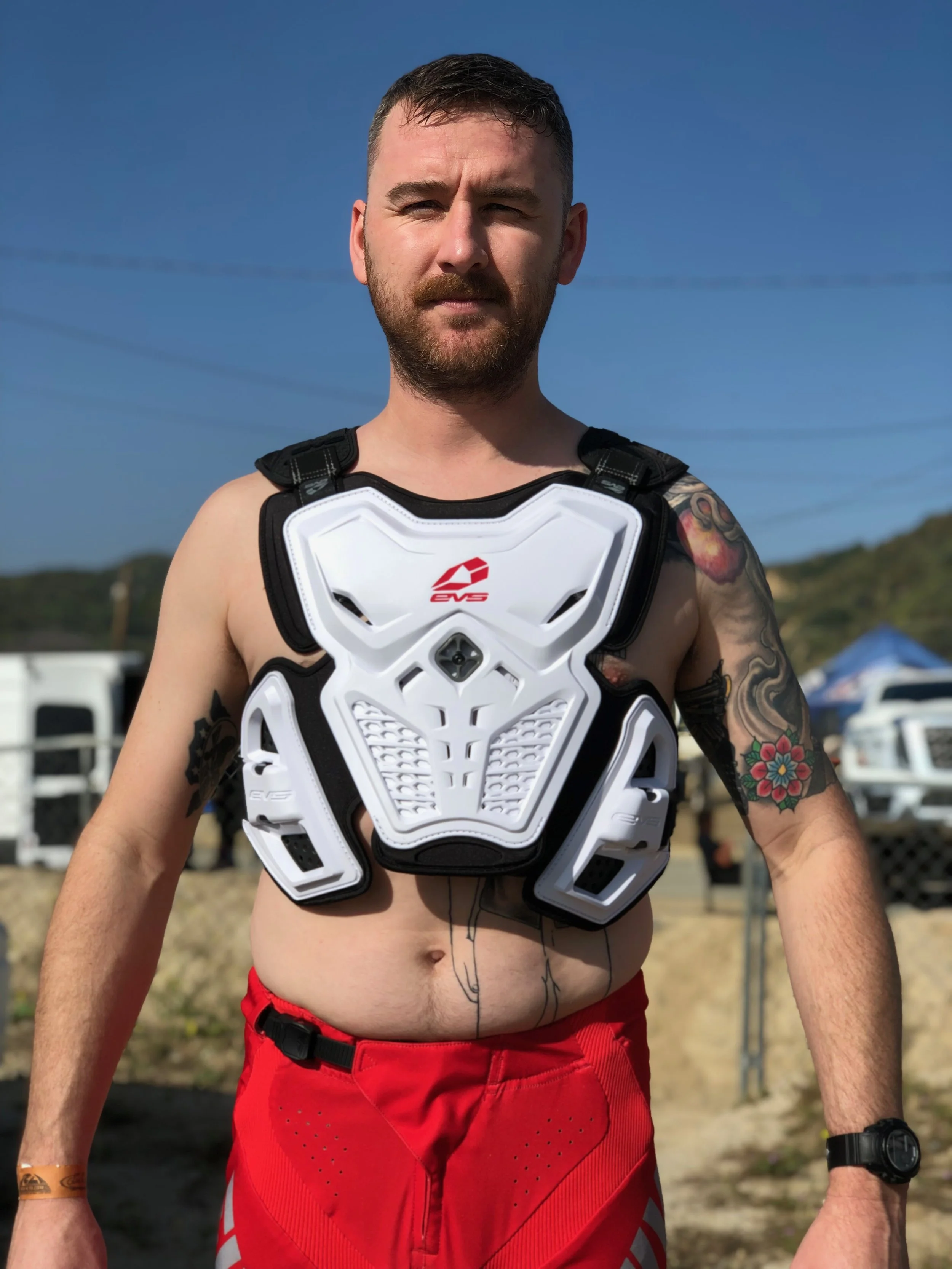When I hear the name EVS, the first thing that comes to mind are those neck donuts that most of us wore when we were kids, or really anything safety gear in general. You know that EVS takes safety seriously if none other than Travis Pastrana has trusted them to protect his banged up body year after year. I was recently contacted by EVS to try their all new for 2019 F-2 roost deflector and see what I thought of it. The older I get the more and more I find it necessary to wear a chest protector (seeing as I don’t quite bounce off the ground like I used to). Being primarily an off-road rider I have worn a plethora off brands and configurations when it comes to roost guards and have become slightly picky about the balance between comfort, protection, and ventilation so this test was right up my ally.
EVS went back to the drawing board for 2019 and re-designed the F-2, integrating some new technology into the deflector. The F-2 has a pivoting system built into the body of the unit that helps keep the guard form pinching on the rider no matter the contortion of the torso. Also integrated into the guard are flow vents to help keep air moving across the body. This is used in conjunction with the Flyte liner which is a grid of impact dampening pads that lift the protective gear off the skin, allowing for increased air flow. The F-2 comes in either white or black as well as being offered in small, medium, large, and extra-large all while being completely adjustable to fit a large array of riders. This deflector meets CE standard 14021 for roost deflection, as well as CE standard 1621-1 for back impact protection. Leatt/Atlas neck braces are compatible with the F-2 and it comes with elastic shoulder loops that help keep the neck brace in place.
Now that you know all about the technical aspects to the F-2 let’s get down to how I liked it out on the trail and track. To start with, since this is a “roost deflector” and not a full “chest protector” it doesn’t come with bulky shoulder cups. In my book this is a plus because those are usually the first thing I take off of a guard that has them. On top of that it doesn’t come with those dumb upper arm protectors that you have to slip your hands through, which I also remove because they are almost always super uncomfortable. Although I am glad there aren’t shoulder cups, I do think the pads that are on the shoulders could be a little larger and more protective for my frame. I am 6’ 185 pounds (although the pictures look like I’m 285 pounds) and I wear a large F-2 which fits pretty good out of the box. For height adjustment there are four adjusters on the shoulder straps (two per side) but they are pretty short and only allow for minimal fine tuning. When it comes to fine tuning for the waist, the side straps allow for a considerable amount of adjustment so that you can get a snug fit. The pivot system on the front of the guard is very functional and works well when you are leaning or contorting your body on the bike, so you don’t feel as though the guard is stabbing you or giving you any pinch points. The hard plastic front and back provided substantial protection from roost and trailside hazards as well as offering padded and hard protection on some small crashes that I experienced. The hard plastic is sewn to the thick padded under protection making the guard solid feeling, but it also feels a little on the heavy side. In terms of protection/comfort it was a big plus, but in terms of wearing it in mid June for a 102 degree motocross race, the deflector was definitely on the hot side. When worn under the jersey the F-2 majorly lacked air flow (also when worn under the jersey, the F-2 looks slightly bulky).
When worn over the jersey the air flow was more noticeable, but still the amount of foam under the plastic proved to be too much of an air block to be able to keep me cool. For me when it comes to roost deflectors there are three main categories; comfort, protection, and ventilation. The F-2 is very comfortable for a heavy duty style roost deflector, as it doesn’t give you any pinch spots are discomfort. The protection of the F-2 for a roost guard is very good and I feel like it gives protection for both decent sized crashes as well as plain old roost. When it comes to ventilation I feel like the F-2 does the best it can for the amount of coverage and protection it offers. Even with vent holes and the Flyte liner, which creates an air gap between the skin and guard, it’s still very hot to wear in summer. I am actually looking forward to wearing this deflector in the winter when you may want something to help keep the body heat in. The F-2 seems to bridge the gap between full chest protection and a minimalistic roost deflector. Other than being hot I feel that EVS did a great job of re-designing the F-2. When it comes to keeping riders safe and comfortable, I think the F-2 is a great option, but you may want to consider another option from EVS when it comes to those hot summer motos. Coming in at $139.00, the F-2 isn’t the cheapest option on the market, but I feel that for the amount of protection it offers, $139.00 is a ball park price point. If you have any questions about the EVS F-2 roost guard feel free to reach out to me at Michael@keeferinctesting.com.









